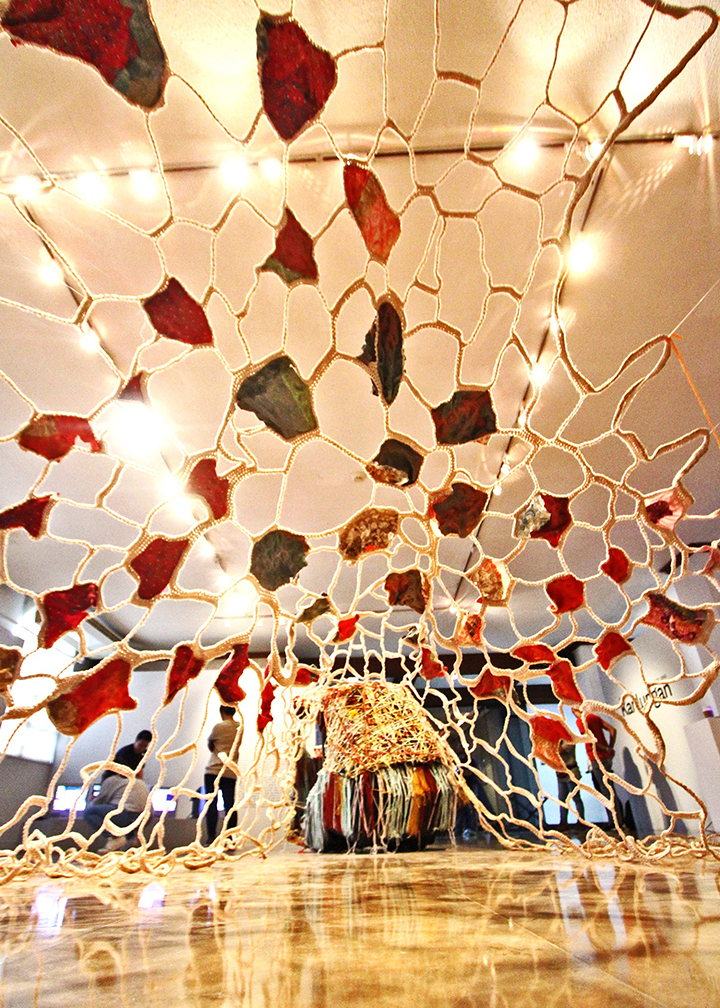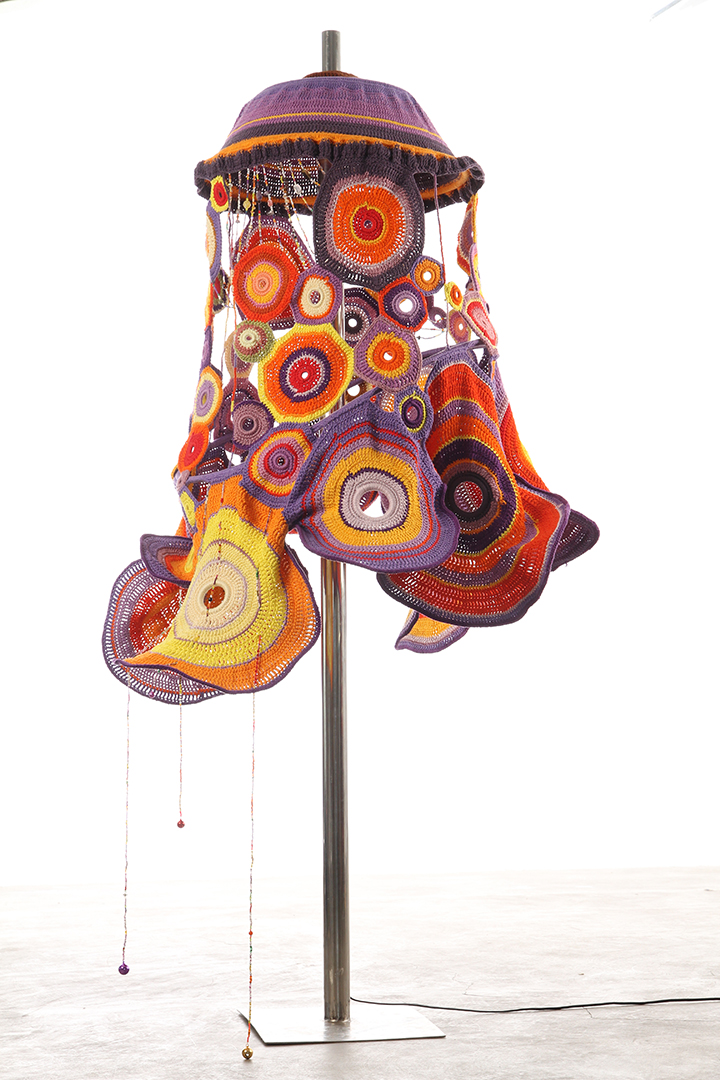Meet Filipino contemporary artist, Aze Ong.

Tell us a little bit about yourself.
I am Aze Ong, a contemporary artist working with fiber. My art practice is about using fiber as a medium which includes history, culture and my ecology around it. I remember growing up being exposed to fabric, thread and sewing machines when my mom pursued her love for clothes starting out in our garage. I would play “bahay bahayan” (playing house) with our seamstress’ daughter using excess fabrics, umbrellas, threads and imagine them as walls, food, bed, curtains, anything that plays in the mind. My mom involved me in her garments business sewing buttons onto summer dresses and blouse and skirts she designed paying me 5 cents per button sewed. I called the process of locking the stitches of a button “around the world” as it creates a circular movement while knotting. Little did I know that these experiences will shape my future and lead to a journey in the world of art.
I am currently working on an experiential performance entitled Queen. The project started in New York during my residency at the Bliss on Bliss Art Projects where I initially wanted to explore on public art. Wanting to hang my works on the trees around the vicinity of the studio, we needed to apply for a permit to the New York City parks and forestry. Pressed for time and uncertainties of the permit being granted, I deviced a “rolling sculpture” where I placed my work on an IV pole and walked with it in the streets of Queens and Manhattan. The first Queen mobile monument was completed in Queens, the borough named after Queen Catherine of Braganza. However, this project had its origin starting from an artist residency in the Kingdom of Saudi Arabia for the King Abdulaziz Camel Festival where along with 40 international artists, an artist from Macedonia Atanas Atanasoski made an artwork that looked like a crown and put it on my head, figuratively proclaiming me a Queen and myself embracing it. The project is currently progressing as I continue to experience and ask questions.
Describe the city you’re living in and what it’s like to live there.
I grew up in Antipolo in the province of Rizal where it used to have abundant nature and soil to dive and play with. When I married, we have been living in Quezon City. Our location is walking distance to different malls, markets and transportation systems like LRT and MRT which made me decide to give up driving and use public transportation instead. Aside from freeing myself from maintenance problems and bearing traffic and parking challenges, it forces me to walk that should help my sedentary lifestyle and observe more of the lives of other people. Now that there is COVID crisis, I can easily walk to the supermarket that proves easy access to what is essential.
My mom involved me in her garments business sewing buttons onto summer dresses and blouse and skirts she designed paying me 5 cents per button sewed. I called the process of locking the stitches of a button “around the world” as it creates a circular movement while knotting. Little did I know that these experiences will shape my future and lead to a journey in the world of art.
What is the best and worst thing about living in your city?
The best thing living in Quezon City is having easy access to the mall, markets and transportation systems. Traffic and parking problems are tiresome. Pollution definitely takes away the excitement of walks. There are not enough sidewalks to encourage walking. Noise of busy streets. Queen and I walk in these streets along with the cars and what you can find along the way, it is an adventure all the same.
Give us 3 words that describe what it’s like to be a creative in your city.
Experiential, simplicity, convenient
How did you start your career in art?
Originally a graduate of media production in Assumption College, I thought of being a filmmaker. During college though, I was exposed to visual and performance arts, attending art openings and underground film showing and performance arts. At that time I enjoyed the experience and visual forms but was not so curious about its meaning and purpose. From being a national athlete to accidentally exploring Kibangay Bukidnon during my volunteer year for the Associate Missionaries of the Assumption where the creative process of the indigenous people have largely influenced me, to working in our family business, to working for the longest-running local noontime show in the entertainment business, to putting up my own business which failed that led me to cope up through crochet believing it calmed me until 12 years later, Lirio Salvador an artist who is the father of sound art in the Philippines who created sculptural assemblages utilizing kitchen utensils and I met again in one of his performances. About to exhibit my crocheted bags, he told me I was making art. This time, I asked questions about art and it started my journey.
His question I laugh at now: You want to crochet for the rest of your life? Yes, was my answer. His face showed an identifiable question mark, confusion, and obscurity. But he felt my conviction and I assumed he found comfort in that.
Were the people around you supportive of your decision on working as a creative?
It was difficult to understand the direction I was taking. Aside from it being a risk full of uncertainties, I also questioned my chosen medium. Having said this, my husband Norman who is an art educator has always had my back. My family and my in-laws have always been very supportive of my art. I remember my 97 year old mother in law, Mama Marina who recently passed, kept my exhibition invites and newspaper clipping, she shows it to her friends, to other relatives and visitors.
That time in 2010 where I felt that this was my calling, I told my father that this was what I wanted to do for the rest of my life. His question I laugh at now: You want to crochet for the rest of your life? Yes, was my answer. His face showed an identifiable question mark, confusion, and obscurity. But he felt my conviction and I assumed he found comfort in that. Years later, he was telling his mother (in the context of seeing me crochet everywhere): Mom, Aze is going to New York for 6 months. My grandmother asked: What is she going to do in New York? My father answered: She will crochet! Knowing that I have their support make challenges easier to bear.
What are some goals and ambitions you have for your future work?
I hope to continue to be able to do what I do, to be able to continue learning and to incorporate other mediums with fiber. I am most interested in learning ceramics to be able to incorporate it into my work. However, I have been longing to incorporate more steel, wood, paper, and resin. And dreaming to be able to exhibit in MoMA.
I hope to continue to be able to do what I do, to be able to continue learning and to incorporate other mediums with fiber.
If you could collaborate with any person in the world who would it be?
Vincent Van Gogh is another dream in another life.
Smitten by Kemang Wa Lehulere during Performa17, I hope we can collaborate both in visual and performance art.
How would you describe the women around you?
Women, just like art – the imperfection makes it perfect.
Women, just like art – the imperfection makes it perfect.
Were there any local female creatives that you looked up to when you were growing up?
Tough question. Not knowing I’d pursue art, much more using fiber as my medium, I have no one in mind. Digging deeply, I would enumerate the women who have helped shape my future: My mom who’ve always involved me in her passion for clothes, from procurement of fabrics, threads and accessories, to just being surrounded by seamstresses and embroiderers, to teaching me how to sew, knot and embroider. To the seamstresses who surrounded me. To the seamstress’ daughter I played with at our young age we agreed that a piece of cut fabric is wall, or a plate, or a hotdog that encouraged my imagination. To those women who have boldly told me that a striped green shorts does not go well with a green floral printed shirt, just because they encouraged me to speak my mind without changing my idea of wearing something that later on was called coordinates. To those female teachers who taught us different subjects especially in Home Economics where I learned sewing, crochet, knitting, macrame, beading and other hand skills. To the indigenous weavers who have shaped our culture and have used signs, symbols in weaving as a visual language valued and accepted.
Are there any challenging aspects of being a female in your industry?
It was challenging to use fiber as a medium for the arts here in the Philippines. It is relatively new. Many may argue this. However, the hardships I encountered were real. As I was starting, many would ask if my works are defined as art, others would suggest that I paint instead, a gallery owner once told me “we do not accept that kind of work,” while some would directly say that’s not art. I think it was a blessing I was not trained as an artist because I myself questioned my medium and I can now say that it was the key to understand and be able to answer my own questions.
Don’t let anybody tell you it is not possible, because it is possible.
Do you have any advice to young women who are aspiring to work in your field?
Don’t let anybody tell you it is not possible, because it is possible. Never let anybody tell you that you can’t, because you can!
Photos courtesy of Aze Ong, Albert Labrador, MM Yu, Jeremy Agsawa, Ralph Meting, Koki, Cultural Center of the Philippines, and The Drawing Room Contemporary Art.













